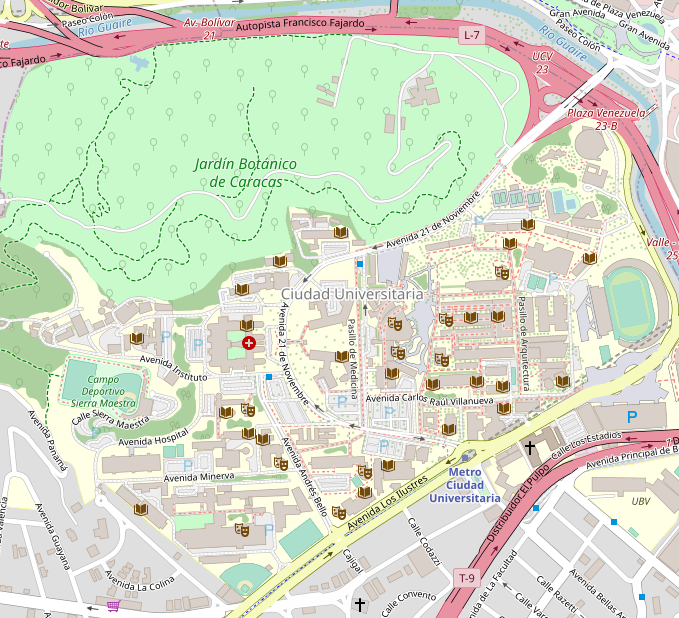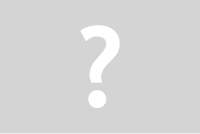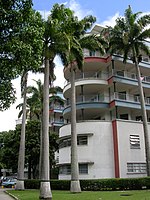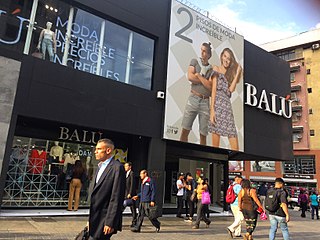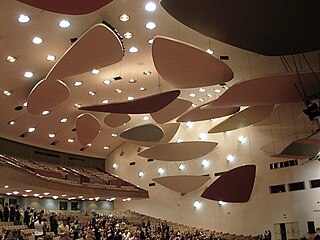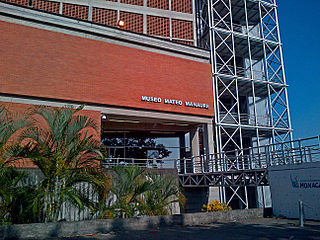| UNESCO World Heritage Site | |
|---|---|
Artworks within the University City [lower-alpha 1] | |
| Location | University City of Caracas, Venezuela |
| Criteria | Cultural: (i), (iv) |
| Reference | 986 |
| Inscription | 2000 (24th Session) |
The University City of Caracas is a World Heritage Site in Caracas, Venezuela. It is a functional university campus for the Central University of Venezuela, as well as home to 108 [6] notable works of art and famous examples of creative architecture. Many works of art are modernist and mosaic. The campus was designed by architect Carlos Raúl Villanueva, who oversaw much of the construction and design work, with the artwork overseen by Mateo Manaure.
Contents
- By Venezuelan artists
- "El primer libro"
- Francisco Narváez
- Alejandro Colina
- Armando Barrios
- Carlos Gonzaléz Bogen
- Mateo Manaure
- Héctor Poleo
- Carlos Raúl Villanueva & Juan Otaola Paván
- Harry Abend
- Pedro León Castro
- Pascual Navarro
- Alírio Oramas
- Alejandro Otero
- Oswaldo Vigas
- Victor Valera
- Miguel Arroyo
- Braulio Salazar
- Jesús Rafael Soto
- Omar Carreño
- Félix George
- Gego
- Ernest Maragall i Noble
- Guillermo Pinto
- Ibelise Lagos
- Oswaldo Lares
- Pedro León Zapata
- Oscar Olivares
- By international artists
- Alexander Calder
- Henri Laurens
- Baltasar Lobo
- Antoine Pevsner
- Jean (Hans) Arp
- André Bloc
- Fernand Léger
- Victor Vasarely
- Sophie Taeuber-Arp
- Wifredo Lam
- Pablo Toscano
- Map of artworks
- Complete list
- Notes
- References
Villanueva primarily enlisted artists who were either European or had European influences – Villanueva himself had been inspired for the campus design in Paris – including members of Los Disidentes, a group of Venezuelan artists who left for Europe to break from the Mexican mural tradition. [7] Some artists did not initially want to work on the project, as they were opposed to the military dictatorship in place in Venezuela at the time, but French artist Fernand Léger encouraged them to participate by saying that "dictatorships pass but art remains"; part of Villanueva's intention was unity. [8] Latin American art scholar Monica Amor wrote that Villanueva's Synthesis of the Arts philosophy, inspired by an André Bloc approach, "advocated a strong humanist approach to urban issues of reconstruction and social healing after the devastation of World War II." [9] : 33 Amor noted that debate surrounding the dictatorship's funding of the project, and its realization in this context, persists into the 21st century. [9] : 33
Catalan urbanist Josep Lluís Sert was involved with the Spanish pavilion at the 1937 Paris Exhibition, which was opposite the Venezuelan pavilion that Villanueva helped create; Sert's pavilion (especially the patios) as well as the ideals of the Exhibition greatly inspired Villanueva, who would become friends with Sert after the war. Sert visited the University City in the early 1950s and introduced Villanueva to Alexander Calder. [9] : 34–35
The experience of the artwork and of the campus architecture was intended to be appreciated by moving through it, something inspired by Le Corbusier (and, in turn, Arab architecture). In the Plaza Cubierta, the center of the campus (and, at conception, Caracas), the organic forms of the winding pathways contrasts with the regular grid of its support structures, which is reflected in the artworks: curved walls support murals, breeze blocks frame design elements. [9] : 36–37 In their book Modern Architecture in Latin America: Art, Technology, and Utopia, Carranza and Lara discuss the "movements" of Villanueva's Synthesis of the Arts, and the functions of certain pieces within their spaces.
Space is known through something that moves: the object or the spectator, and walking reveals to our vision the diversity of events.
Despite the philosophy of synthesis, criticism from the 1970s and the 2020s notes that not all works on the campus contribute equally as functional and artistic pieces; sculptures may not become part of the structures in the same way as murals, while some works were designed without ever seeing the campus. However, the same critics agreed that most of the works were "space definers" and as such were architectural by nature as well as artistic by design. [9] : 36
Amor wrote that the individual artworks creating the spaces of the campus "cannot be assessed individually". She describes many of the murals on the campus as showing "repetition, discontinuity, compression and expansion, dynamism, rhythmic composition, contrasting shapes, geometric organization, and anti-hierarchical allover-ness." [9] : 37

